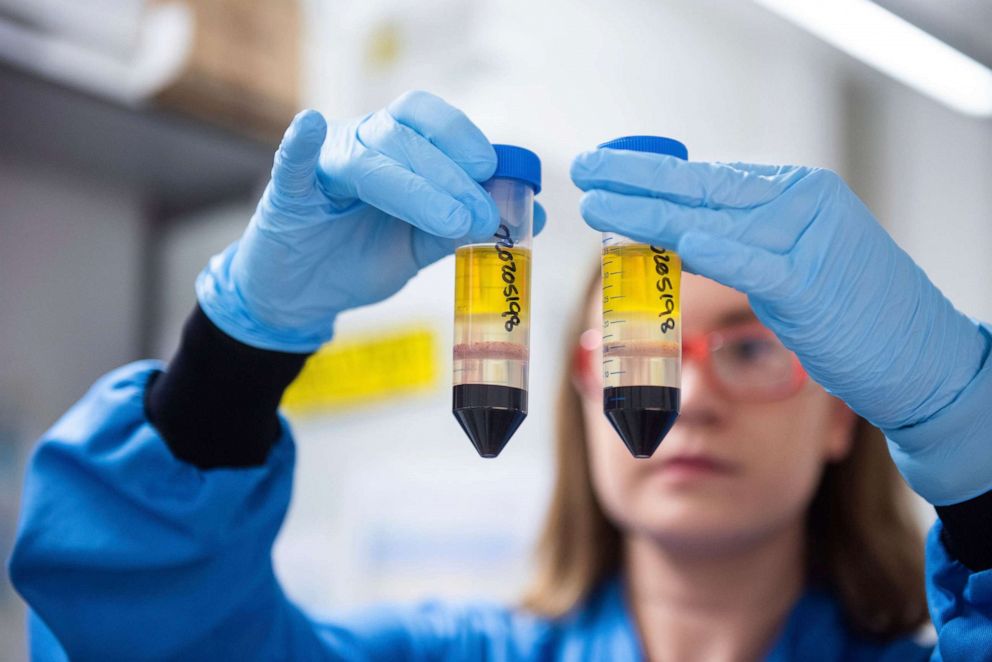Why questions are being asked about AstraZeneca/Oxford’s COVID vaccine data
"AstraZeneca/Oxford get a poor grade for transparency."
The British government said Friday it has formally requested its medicines regulatory agency to consider the Oxford/AstraZeneca vaccine for regulatory approval.
“We are working tirelessly to be in the best possible position to deploy a vaccine as soon as one is approved by the independent regulator the MHRA,” U.K. Health Secretary Matt Hancock said in a statement, referring to the Medicines and Healthcare products Regulatory Agency.
This is the second COVID-19 vaccine that the MHRA is reviewing; the other is the Pfizer/BioNTech vaccine.
The agency could authorize both vaccines under special legislation known as Regulation 174, which enables the temporary supply of medicines to be authorized in response to a public health crisis.
Oxford University and AstraZeneca announced its trial results on Monday but has since suffered a barrage of criticism over how they had collated and presented the interim results for the third and final phase of their AZD1222 vaccine trials.
Both the university and the pharmaceutical giant have defended their practices and their product. “The studies were conducted to the highest standards,” an AstraZeneca spokesperson told ABC News on Thursday.
In a joint press conference on Monday, the teams announced their vaccine was 62% and 90% effective, depending on the level of dose given. Their trials had followed two different dosing regimens – the first used two regular doses and reached 62% efficacy. The second had a lower dose, followed by a regular dose, with an efficacy of 90%, researchers said.

They presented the overall efficacy as an average of 70%, a method considered unorthodox by some. Oxford University explained to ABC News it intends to submit this average efficacy reading of 70% to regulators for approval. European and U.K. regulatory bodies have been conducting a rolling review of all the trial data.
But questions are now being raised about whether the approval process will go smoothly. Shortly after the press release and initial excitement at the good news, questions began to emerge about how they collected and presented the data, including why researchers used two dosing regimens and whether the results can be combined into an average.
“AstraZeneca/Oxford get a poor grade for transparency and rigor when it comes to the vaccine trial results they have reported,” Natalie E. Dean, assistant professor of biostatistics at the University of Florida, said in a series of tweets on Tuesday. “This is not like Pfizer or Moderna where we had the protocols in advance and a pre-specified primary analysis was reported.”
She added, “In fact, the trials seem to be quite different by country, in terms of populations, subgroups, etc.”
She also questioned the inclusion of two dosing regimens.
“If they seek to get the half-dose approved, they should wait until they have a compelling result. Otherwise, we can land in ‘evidence limbo,’" she said.
Ian Jones, professor of virology at the University of Reading, told ABC News the data was confusing. “The phase III data as released in the press release is garbled and obviously confusing ... how should a person judge that? Even those running the trial openly admit they don't know why they got the outcome they did.”
Some wondered if the confusion surrounding this vaccine stemmed from a press release that broke down complicated scientific information in bite-size nuggets. Two other companies with late-stage vaccine data -- Moderna and Pfizer/BioNTech -- also released their topline results in press releases.
The field of vaccine research isn’t accustomed to operating under such immense media scrutiny. Every step the Oxford/AstraZeneca team has taken has been followed by a global media stampede. Dean and other experts felt clarity was lacking on Monday.
“I'm glad this is not the first vaccine to read out, because it is awfully confusing for experts and non-experts alike,” Dean tweeted.
Oxford and AstraZeneca have both explained that once the complete data has been peer reviewed and published, the public will have a greater understanding of the trials’ parameters. They also sought to clarify how the dosing error came about, explaining it was due to an issue in how the intensity of the doses was measured.
A lower dose had entered the trial system and was given to some 2,800 people before the mistake was identified.
“We have different ways of measuring the concentration of the vaccine and when it was apparent that a lower dose was used, we discussed this with the regulator, and agreed a plan to test both the lower dose / higher dose and higher dose / higher dose, allowing us to include both approaches in the phase III trial,” Oxford University said in a statement on Thursday.
AstraZeneca provided more details, explaining that the change in dosing intensity occurred when they went to scale up the amount of vaccines for the trial.
The AstraZeneca statement also makes it clear that there was no safety issue with dosing, saying it “was reviewed by the independent Data Safety Monitoring Board and the U.K. regulator, both of whom approved the continuation of this dosing regimen and the regulator publicly confirmed that there was ‘no concern.’”
But questions also arose about why none of the researchers involved talked about this mistake at the initial press briefing and why the trials had followed this unusual two dosing regimen.
While both the Oxford University and the AstraZeneca press releases stressed that these were interim data, many people -- journalists, scientists and pharmaceutical company executives – initially focused on the positive news and highlighted the 90% efficacy figure.
Not only was this vaccine safe and effective, it could be easily transported and stored, requiring only standard refrigeration for both, according to the release. This was particularly significant given that rival vaccines from Pfizer/BioNTech and Moderna need to be frozen for shipping and storing.
It was not until later that the flaws in these results began to emerge.
On Monday evening, a Reuters reporter asked how the two dosing regimens came about in an interview with Mene Pangalos, the head of AstraZeneca’s non-oncology research and development.
“The reason we had the half-dose is serendipity,” Pangalos told Reuters.
A portion of the trial, revealed to be fewer than 3,000 people, had received a lower initial dose by accident. This was only discovered as this group was experiencing far milder side effects.
In fact, AstraZeneca welcomed this news: Not only was this dosing regimen more effective but it meant there would be more of its product to go around. Another AstraZeneca executive, Ruud Dobber, told ABC News, “The good news is clearly that if you can start with half the dose, we will have more vaccine available and we can start vaccinating a larger group of people around the world."
The dosing error had previously been reported by the Daily Mirror back in June, describing it “as a huge embarrassment for the Oxford Covid-19 vaccine trial.”
Jones, who has been following the trials closely, was quoted at the time, saying he was “surprised” by the error and worried that it might have “an impact upon the clarity of the trial.”
He told ABC News Thursday: “The data in the press release does not invite the public's trust."
“I do not worry that the vaccine is unsafe, all the evidence is that it is," he continued. "But I do worry that if we don't know exactly why the different doses performed as they did, there can be no guarantee that the correct dose will be used going forward. The public need complete openness, what are they going to get and how protected will they be?”
Despite the criticism and confusion that followed Monday’s announcement, the British government is backing the vaccine, with its chief scientific adviser, Patrick Vallance, saying Thursday, “The headline result is the vaccine works and that’s very exciting.”
Some damage, however, has clearly been done. AstraZeneca’s stock price has fallen while competitors Pfizer/BioNtech and Moderna have experienced gains.
Moncef Slaoui, head of Operation Warp Speed, compounded the situation when he told reporters on Tuesday that the 90% efficacy applied to a small sub-group of 2,800, which only included individuals from 19 to 55 years old. No one from the most vulnerable demographic were tested with this dosing regimen.
Pangalos also told reporters on Monday that AstraZeneca intended to submit an application to the U.S. Food and Drug Administration to change their trial protocol in the U.S. to include this lower dose followed by a higher dose regimen, likely leading to slower approval in the U.S.
While the public awaits the full data and peer-reviewed analysis, which should be published “within weeks,” according to Oxford, AstraZeneca will continue to “further investigate the half-dose/full dose regimen.”
“We are further evaluating the data and will work with regulators on the best approach for further evaluation,” an AstraZeneca spokesperson said.
Meanwhile, both the European and U.K. regulators will continue reviewing the data and will determine whether to approve the vaccine.




